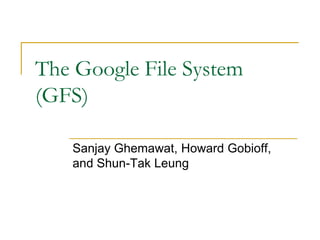
tittle
- 1. The Google File System (GFS) Sanjay Ghemawat, Howard Gobioff, and Shun-Tak Leung
- 2. Introduction Design constraints Component failures are the norm 1000s of components Bugs, human errors, failures of memory, disk, connectors, networking, and power supplies Monitoring, error detection, fault tolerance, automatic recovery Files are huge by traditional standards Multi-GB files are common Billions of objects
- 3. Introduction Design constraints Most modifications are appends Random writes are practically nonexistent Many files are written once, and read sequentially Two types of reads Large streaming reads Small random reads (in the forward direction) Sustained bandwidth more important than latency File system APIs are open to changes
- 4. Interface Design Not POSIX compliant Additional operations Snapshot Record append
- 5. Architectural Design A GFS cluster A single master Multiple chunkservers per master Accessed by multiple clients Running on commodity Linux machines A file Represented as fixed-sized chunks Labeled with 64-bit unique global IDs Stored at chunkservers 3-way Mirrored across chunkservers
- 6. Architectural Design (2) Application chunk location? GFS Master GFS client GFS chunkserver chunk data? GFS chunkserver Linux file system GFS chunkserver Linux file system Linux file system
- 7. Architectural Design (3) Master server Maintains all metadata Name space, access control, file-to-chunk mappings, garbage collection, chunk migration GPS clients Consult master for metadata Access data from chunkservers Does not go through VFS No caching at clients and chunkservers due to the frequent case of streaming
- 8. Single-Master Design Simple Master answers only chunk locations A client typically asks for multiple chunk locations in a single request The master also predicatively provide chunk locations immediately following those requested
- 9. Chunk Size 64 MB Fewer chunk location requests to the master Reduced overhead to access a chunk Fewer metadata entries Kept in memory - Some potential problems with fragmentation
- 10. Metadata Three major types File and chunk namespaces File-to-chunk mappings Locations of a chunk’s replicas
- 11. Metadata All kept in memory Fast! Quick global scans Garbage collections Reorganizations 64 bytes per 64 MB of data Prefix compression
- 12. Chunk Locations No persistent states Polls chunkservers at startup Use heartbeat messages to monitor servers Simplicity On-demand approach vs. coordination On-demand wins when changes (failures) are often
- 13. Operation Logs Metadata updates are logged e.g., <old value, new value> pairs Log replicated on remote machines Take global snapshots (checkpoints) to truncate logs Memory mapped (no serialization/deserialization) Checkpoints can be created while updates arrive Recovery Latest checkpoint + subsequent log files
- 14. Consistency Model Relaxed consistency Concurrent changes are consistent but undefined An append is atomically committed at least once - Occasional duplications All changes to a chunk are applied in the same order to all replicas Use version number to detect missed updates
- 15. System Interactions The master grants a chunk lease to a replica The replica holding the lease determines the order of updates to all replicas Lease 60 second timeouts Can be extended indefinitely Extension request are piggybacked on heartbeat messages After a timeout expires, the master can grant new leases
- 16. Data Flow Separation of control and data flows Avoid network bottleneck Updates are pushed linearly among replicas Pipelined transfers 13 MB/second with 100 Mbps network
- 17. Snapshot Copy-on-write approach Revoke outstanding leases New updates are logged while taking the snapshot Commit the log to disk Apply to the log to a copy of metadata A chunk is not copied until the next update
- 18. Master Operation No directories No hard links and symbolic links Full path name to metadata mapping With prefix compression
- 19. Locking Operations A lock per path To access /d1/d2/leaf Need to lock /d1, /d1/d2, and /d1/d2/leaf Can modify a directory concurrently Each thread acquires A read lock on a directory A write lock on a file Totally ordered locking to prevent deadlocks
- 20. Replica Placement Goals: Maximize data reliability and availability Maximize network bandwidth Need to spread chunk replicas across machines and racks Higher priority to replica chunks with lower replication factors Limited resources spent on replication
- 21. Garbage Collection Simpler than eager deletion due to Unfinished replicated creation Lost deletion messages Deleted files are hidden for three days Then they are garbage collected Combined with other background operations (taking snapshots) Safety net against accidents
- 22. Fault Tolerance and Diagnosis Fast recovery Master and chunkserver are designed to restore their states and start in seconds regardless of termination conditions Chunk replication Master replication Shadow masters provide read-only access when the primary master is down
- 23. Fault Tolerance and Diagnosis Data integrity A chunk is divided into 64-KB blocks Each with its checksum Verified at read and write times Also background scans for rarely used data
- 24. Measurements Chunkserver workload Bimodal distribution of small and large files Ratio of write to append operations: 3:1 to 8:1 Virtually no overwrites Master workload Most request for chunk locations and open files Reads achieve 75% of the network limit Writes achieve 50% of the network limit
- 25. Major Innovations File system API tailored to stylized workload Single-master design to simplify coordination Metadata fit in memory Flat namespace